St Joseph's Advocate - Autumn 2012 - The Mill Hill Missionaries
St Joseph's Advocate - Autumn 2012 - The Mill Hill Missionaries
St Joseph's Advocate - Autumn 2012 - The Mill Hill Missionaries
You also want an ePaper? Increase the reach of your titles
YUMPU automatically turns print PDFs into web optimized ePapers that Google loves.
2<strong>Autumn</strong> <strong>2012</strong>
Lord God,As you are the fount of mercy and wish all people to be saved:Have mercy then on our deceased brethren, relatives, and benefactors.Through the intercession of Blessed Mary ever-virgin, and of all your saints,Bring them to the fellowship of eternal joy. Through Christ our Lord. Amen.2Our annual Tree of Life Mass will take place in Nazareth House Chapelon Sunday November 25th at 3.00pmContentsPage 3 Editorial.Page 5 Journey into the Heart ofDarkness.Page 9 Franciscan <strong>Missionaries</strong> of<strong>St</strong> Joseph.Page 12 Fr Paul Mooney:Silver Jubilee.Page 15 50th Eucharistic Congress,Dublin, <strong>2012</strong>.Page 19 Silver Circle helps newhealth centre.Page 21 Letter from a youngMissionary.Page 23 Obituaries.Page 24 <strong>The</strong> Year of Faith.Page 26 A visit to Rachel’s Tomb.AcknowledgmentsContributors:Fr Fons Eppink mhmFr Paul Mooney mhmSr Anne Moore fmsjFr Suresh mhmFr Matt Grier mhmPhoto Credits:Fr Fons Eppink mhmFr Paul Hien mhmFr Suresh mhmSr Anne Moore fmsjCover photos:Front cover: Basankusu Girl.Back cover: Forest Child.<strong>St</strong>. Joseph’s <strong>Advocate</strong>is the magazine of the <strong>Mill</strong> <strong>Hill</strong> <strong>Missionaries</strong> inScotland, published from <strong>St</strong>. Joseph’s House,30 Lourdes Avenue, Cardonald,Glasgow G52 3QU.Tel: 0141 883 0139.Email: tollanmhm@yahoo.co.ukRegistered Charity Number: SCO39809Produced by:Burns Morrison Print Management Ltd.,Caledonia Business Centre,Thornliebank Industrial Estate, Glasgow G46 8JTTel: 07799 645 420Email: sales@burnsmorrison.co.ukFr. Bill Tollan m h m ,EditorEditorialMake the wordof truth shineWriting about the recent EucharisticCongress, Fr Matt Grier notes the conspicuouspresence as helpers and participants ofCatholics from what are usually thoughtof as ‘missionary countries.’ Many of theseCatholics are now vital participants in thelife of Parishes all over these islands. <strong>The</strong>yare the fruits of the work of missionaries, andso of all those who have supported the workof our Missionary Society. In his message forthis year’s Mission Sunday (October 21st)Pope Benedict calls on us all to ‘Make theWord of Truth Shine.’ Mission Sunday thisyear will inaugurate a ‘Year of Faith’. On thesame day, the Synod of Bishops will meet inRome; the theme of this year’s Synod is theNew Evangelization. Blessed Pope John PaulII wrote that “We cannot be at peace whenthinking of the millions of our brothers andsisters...who live in ignorance of the love ofGod.” And Pope Paul VI insisted that theChurch’s missionary work was not ‘optional’for Christians; “...this message is necessary. Itis unique. It is irreplaceable.” <strong>The</strong> missionarymandate demands the commitment of all thePeople of God.3
Sometimes people think that thetask of missionaries is primarilyabout bringing material relief to poorpeople. <strong>The</strong>re are many excellentagencies (SCIAF, Mary’s Meals, e.g.)which engage in such work, andfrequently they collaborate with ourmissionaries, assisting in missionarysponsoredprojects. However, ourprimary task is always to proclaimthe Good News of Salvation, theGood News of Jesus Christ. <strong>The</strong>recan be no evangelization without theexplicit proclamation of the name ofJesus. <strong>Missionaries</strong> are not just socialworkers.Pope Benedict notes howmissionary activity has become anintegral part of the young Churchesin mission areas. This is evident inour own missionary Society, with ouryoung <strong>Mill</strong> <strong>Hill</strong> <strong>Missionaries</strong> fromAfrica and Asia, such as FrDominic from Kenya,Fr Suresh from India,and Fr <strong>St</strong>an fromCongo (see articlesin this issue.)<strong>The</strong>re are also theyoung Kenyan<strong>Mill</strong> <strong>Hill</strong> Sisterswho have joinedour missionaries inNorthern Uganda;the proceeds fromthis year’s Prize Draw andSummer Fair were sent to helpthem get established. <strong>The</strong> new projectat Ilung in Cameroon has been aidedby our friends who support the ‘SilverCircle.’<strong>The</strong> recent successful Olympic andParalympic Games have provided usall with many inspiring examples ofcomplete dedication, self-sacrifice,endurance, and enthusiasm. Reflectingon the Olympics in a recent letter toour members our General Superior,Fr Tony Chantry, wrote, “When thepeople of the world are prepared towork together for a common goal,just about anything can be achieved,to the ultimate good of all. When wehave something important to shareand the determination to do so evenwith the prospect of failure, very littlecan stop us.” We need that kind ofspirit to fire us anew with zeal for theGospel. “Woe to me if I do not preachthe Gospel” wrote <strong>St</strong> Paul to theCorinthians (I 9:16.) Paul was filledwith the fire of the Holy Spirit.<strong>The</strong> high point of the openingceremony of the Olympic Games wasthe lighting of the OlympicCauldron. <strong>The</strong> design ofthis year’s Cauldronsymbolised the unityof humankind. <strong>The</strong>flame had beenpassed in relayand taken roundthe country andeventually lit theindividual ‘kettles’(one for each nationon earth) that rose toform Olympic Flame. <strong>The</strong>missionary task of the Church isto bring the light of Christ to all thepeoples of the world. We are all calledto shine with the ‘Word of Truth’, sothat the hearts of all people will be litwith the love of God revealed in Jesusour Saviour.Journey into the‘Heart ofDarkness’?“Over here Christians of otherdenominations tell us: ‘You, Catholics,‘bovanda kimya’ - better keep quiet.Look at our provincial governor. Youare the ones who educated him!’”Jeanne-Marie Abanda, who headsthe local Caritas office in Mbandaka(Democratic Republic of Congo),speaks with quiet emotion as shedenounces the alleged corrupt dealingsof governor Baende, an ex-priest, whoheads the Equator Province. <strong>The</strong>re isno doubt that D.R. Congo remainsone of the most troubled nations onthe African continent bearing manyof the hallmarks of a ‘failed state’.At the beginning of August this yeartwo hundred thousand Congolesedemonstrated across the country inprotest against yet another armedconflict in the East of the country.by Fons Eppink mhmPublic transport.After two wars in the years around theturn of the century and an estimated2½ million victims, the Congoleseare yearning for peace. This ‘march ofhope for peace’ was organised by theEpiscopal Conference of Congo to ‘sayno to balkanisation, no to war, and yesto peace’. In the absence of operativestructures of governance the CatholicChurch plays a pivotal role in givinga voice to the voiceless and raisingawareness of threats to the integrity ofthe nation.When I left Congo in 1988 afterseventeen years of work as a missionaryin the diocese of Basankusu, I waspainfully aware of the havoc wreakedby the dictatorial Mobutu regime atthe time. Now, twenty four years later,I was returning for a three weeks’ visitat the invitation of the Thérésiennes,4 5
a local diocesancongregationof sisters, whohad requestedaccompaniment fortheir annual retreat.I was, of course,full of anticipation,keen to spotsigns of incipientimprovement inthe general livingconditions of thelocal people withwhom I still feela close bond ofaffection. Was there a glimmer oflight at the end of the tunnel or wasthis going to be a journey into whatJoseph Conrad once famously calledthe ‘heart of darkness’?<strong>The</strong> answer, of course, is notunequivocal. In the capital KinshasaChinese companies are in the processof constructing a multiple lane superhighway linking the airport to thecity centre. But all secondary roadsare in a state of advanced decay. <strong>The</strong>same can be said of the housing in thepopular ‘quartiers’boroughs. Neverwithout a senseof humour theinhabitants havetaken to callingKinshasa no longer‘la belle’, but ‘lapoubelle’(dustbin).Yet the placeis teeming withlife and youth.‘Jupiter’ Bokondji,a popular musician,in an interviewunderlines the<strong>The</strong> Thérésienne Sisters.limitless musical and other potentialof this diverse population. “In five toten years’ time we will have emerged!”,he proclaims confidently.Wiry resilience is the best wayto describe my impression of theway the population of Basankusuhas survived two wars and untoldhardships. This little town (estimatedpopulation 140,000), lost somewherein the immense rainforest coveringthree quarters of this vast country, ismy final destination. I get a first classview from the air as the small ten<strong>The</strong> old Cathedral in Basankusu. <strong>The</strong>re has been adistinct feeling of loss since its demolition.seater plane flies low over the townto make its approach to the airstrip.One landmark is missing. <strong>The</strong> iconicCatholic cathedral has been reducedto a heap of rubble. Built by Jan deKoning, a <strong>Mill</strong> <strong>Hill</strong> brother, duringWorld War II, it had begun to develophuge cracks and was beyond repair.When later on I talked to someof my friends and acquaintances itbecame abundantly clear that thereis a distinct feeling of loss, people arestill in mourning and wondering whatwill replace this unique symbol ofCatholic presence in the area. Togetherwith the death of the first Congolesebishop of the diocese, the charismaticMgr Ignace Matondo, last year, thereis a vague awareness that the Churchhere has come to the end of an era.Transition here too….. And the hopethat something new will arise from theashes? When I left after three weeks Iwas appalled by the general povertyof the people in this far corner of therainforest, but deeply impressed bytheir ability to bounce back, and aboveall celebrate.In this part of the interior basicinfrastructure is almost totally lackingmaking it well-nigh impossible forpeople to market the surplus produceof their fields. Most are engaged insubsistence farming. <strong>The</strong> rainforest hasreclaimed the roads, none of whichare tarmac’d. <strong>The</strong>re is no electricity orrunning water in the town of Basankusu.But- what irony! - a mobile telephonenetwork is fully operational. Educationis in a shambles. Most schools lack asupply of basic textbooks. Formersecondary school students of minewho had themselves become principalsspoke of the absence of any form ofeducational ethic and basic moralFr Fons chats with a friend.standards. Everything is for sale! Oneshudders to think what effect this willhave on present and future generationsof school going youth. Basic healthcareleaves much to be desired, but inBasankusu at least religious sisters ofthe local congregation of Thérésiennessuccessfully run a small hospital andmanage to ensure a basic supply ofmedicines to various dispensariesunder their care.Yet this area too has enormousassets, if only they could be tapped forthe wellbeing of the local population.So far there is only one companydeveloping the huge potential foragribusiness: a large plantation of oilpalms serves mainly for the productionof bio-diesel. <strong>The</strong> presence, in what hasnow become a large forest reserve, ofpigmy chimps, the so-called ’bonobo’s’- our closest cousins in the animal world- holds out a promise of future tourism.But as for the present the infrastructureto make this feasible is totally lacking.And then there is the immenseexpanse of rainforest itself. Variouslogging companies have stripped largeswathes of forest of its most valuablehardwood. But with little or no benefitto the local population.<strong>The</strong> <strong>Mill</strong> <strong>Hill</strong> missionaries laidthe foundation of the Church in67
Fr John Kirwan mhm.Fr Jim Fanning and parishioners.Fr <strong>St</strong>an Bondoko mhm.this part of Congo starting in 1905.Now, more than one hundred yearslater, there is only a small but valiantremnant consisting of two Brits (JohnKirwan and Jim Fanning) and oneCongolese (<strong>St</strong>an Bondoko). <strong>The</strong> localChurch stands on its own feet with agrowing number of local clergy andalso religious. But over the past severaldecades there has been a proliferationof independent, mostly Pentecostal,churches all over the country. When Iasked one of my friends what attractedpeople to these ‘sects’ he spoke of thelively services and exuberant singingwhere everyone can join in, the feelingof empowerment, and the longingfor healing and miracles. No doubtthe economic hardship, the feeling oftotal abandonment and the confusioncaused by a radical cultural transitioncontribute to the search for instantreligious consolation.On my final Sunday in the dioceseI was invited to preside at the liturgyin one of the churches in Basankusu.We celebrated using the Congoleserite of the Mass - a timely, officiallyapproved, adaptation of the Eucharistto Congolese culture. If ever I neededconfirmation that Africans celebrateexuberantly as a community, I found itthere. It so happened that this Sundaythere was a special collection for thebuilding of a new cathedral. I watchedin utter amazement as the offertoryprocession progressed. <strong>The</strong> singinggrew louder and louder as each smallChristian community advanced to thealtar dancing and swinging. <strong>The</strong> wholeprocedure took nearly two hours! <strong>The</strong>proceeds were announced at the endof Mass: $ 226: peanuts in relation towhat is needed, but a huge amountif you consider the dire poverty mostpeople there live in. ‘God loves thejoyful giver’!I stepped on to the small plane thenext day grateful to have reconnected.Bishop Mokobe made a strong plea formore <strong>Mill</strong> <strong>Hill</strong> missionaries to returnfor a shorter or longer period: “Youare our ‘ancestors in the faith’. Wewant you to be with us, like grandparentsremaining with their grownupchildren. We need your presence.”Franciscan <strong>Missionaries</strong>of <strong>St</strong>. Joseph<strong>Mill</strong> <strong>Hill</strong> Sister Anne Moore, from Glasgow, writes about her Congregation,and about their new mission alongside our MHM’s in Panyangara,Diocese of Kotido, Northern Uganda<strong>The</strong> town of Kisumu on the shoresof Lake Victoria in Western Kenya isa far cry from Shawlands in the southside of Glasgow where I grew up. Butthis is the direction my life has takenme as a Franciscan Missionary of <strong>St</strong>.Joseph. I joined the congregationbecause I was attracted to themby the nice pictures of nuns onmission in Africa in their Missionarymagazine. This was the way Godplanted the seed of vocation in myheart, the call to greater intimacywith God as well as to a Franciscanway of life in community andministry. After initial formation andteacher training in Manchester Iset off for Kenya where I remainedfor over thirty years sharing my lifewith people who are among themost isolated, vulnerable, voicelessand marginalized in our world.Who We Are<strong>The</strong> Franciscan <strong>Missionaries</strong> of<strong>St</strong> Joseph are an internationalcongregation founded in 1883by Alice Ingham who camefrom Rochdale, in the northof England. Alice had a strongdesire to do something specialfor God and a longing to be amore compassionate presence inthe world. By forming communitywith like-minded local women, allmembers of the Franciscan ThirdOrder, Alice was led to a deeper andmore meaningful expression of theGospel through her ministry tothose around her. As followersof Francis of Assisi andAlice Inghamtoday, wehave asimplelifestylein8Young warrior.9
community, serving the Church inwhatever way we can.Where We AreAt the present time the Franciscan<strong>Missionaries</strong> of <strong>St</strong>. Joseph are livingand serving in the UK, Ireland, Kenya,Uganda and Ecuador. Our biggestgrowth in terms of vocations is inKenya where we have young womenjoining our congregation everyyear. We have eight communities inKenya and one in northern Uganda,opened last year.How We ServeOur sisters respond with flexibilityand courage to the ever-changingneeds of the time and as such weare involved with people whostruggle to survive on a daily basis.One example is our new mission inKotido, northern Uganda, amongthe Karimojong people. In thisarea the mortality rate for pregnantwomen and their unborn babies ishigh because they cannot accessmaternal and child health clinics.<strong>The</strong>re are many malnourishedchildren and children who are notimmunized which adds to the highchild mortality rate. <strong>The</strong>re is a lackof access to safe drinking water alsocontributing to the high rate ofdisease. <strong>The</strong> school drop out rate ishigh. One of the reasons for this ishunger. School attendance dependson the availability of food providedby the World Food Programme. Fourof our Kenyan Sisters went there lastAugust to work alongside the <strong>Mill</strong><strong>Hill</strong> <strong>Missionaries</strong> in Panyangaramission, and they hope to make adifference tothe lives of thepeople thereby trying toaddress theseneeds.Both inKenya and inEcuador weare involvedSr Ann Moore visitingPanyangara. in teachingin the poorerareas, community based healthcare programmes, <strong>St</strong>reet Children’sprogrammes, and in services fordisabled children who are generallyhidden at home. We are alsoinvolved in pastoral and social workin various areas, one of which ishelping widows and orphans whoare trying to survive in the direstof circumstances. Many men werekilled in the post election violencethat erupted in Kenya in December2007 after the disputed presidentialelections. <strong>The</strong>ir widows andorphaned children lost everything<strong>The</strong> four FMSJs on mission to Kotido.and oftenhad to movefrom the areawhere theylived to theirtribal homeareas. Onesuch familyis that ofLucy Atieno.When I firstmet Lucy shewas prettyLucy and family.desperate.She had lost her husband and herhome in January 2008 when a gang oftwenty to thirty men forcibly enteredtheir house at midnight, took Denis,her husband, outside and killed him.<strong>The</strong>y told Lucy to take her childrenand run and not to look back or theywould also be killed. Lucy went withher children to the police station andthen to one of the camps that werealready forming on the outskirts ofthe town. After three months in thecamp, and resigned to the fact thatshe would never find her husband’sremains to bury him, she and her fourchildren boarded one of the lorriesthat was transporting people back totheir own tribal areas. Lucy wantedto start a small business of cookingfood so that she could support herselfand her children. I was able to helpLucy get her business started andsend her children to school. Lucy hasbuilt a small kiosk and it is here thatshe cooks and sells food for the localpeople and this has given her hopefor the future.In the UK we minister in parishes,chaplaincies, and homes for theelderly, are active in missionawareness, and help the homeless invarious ways. We care for childrenand families through involvementwith Caritas (Diocese of Salford) andFrancis House which is a children’shospice.As Franciscan <strong>Missionaries</strong> of<strong>St</strong>. Joseph we believe that we havesomething to offer our world today.We are called to bring hope to thosearound us, sharing the desire of <strong>St</strong>.Francis of Assisi to be at the serviceof the Church and at the heart of herlife.<strong>The</strong> proceeds of the SummerFair and Draw this year madeit possible for us to send £2,000to help the Sisters in their newproject in Northern Uganda.Many thanks to all whocontributed in any way to makethis possible.1011
12Fr. Paul F Mooney mhmOn the 26th of July, 1987 I wasOrdained Priest for the <strong>Mill</strong> <strong>Hill</strong>Missionary Society in <strong>St</strong>. Columbkille’sparish, Rutherglen. As I am sure youcan imagine, it was a day of great joy forme, my family, friends and colleagues.After ten years of preparation, the dayfinally came for me to embrace HolyOrders.My journey to the Priesthoodbegan in 1977 at Campion HouseCollege, Osterley. Runby the Jesuit Fathers,Campion Houseassisted over onethousand four hundredmen to ordination.Sadly, after more thaneighty years, it wasdecided that CampionHouse College was nolonger needed. I amstill proud to refer tomyself as an “Osterley”man, and I shall beforever grateful tothe Jesuit staff thathelped me appreciateacademic study.I attended CampionHouse College as acandidate for Priesthood with theArchdiocese of Glasgow, my homeDiocese at that time. However, in myheart lay a yearning for travel and anSilver Jubilarian <strong>2012</strong>appreciation forforeign mission. Ashort experienceworking with BlessedMother Teresa’s <strong>Missionaries</strong> of Charityin Calcutta confirmed the orientationof my vocation to Priesthood. Aftercompleting my Philosophy studiesat <strong>St</strong>. Peter’s Colleges Cardross andNewlands, I transferred formation forPriesthood to the <strong>Mill</strong> <strong>Hill</strong> <strong>Missionaries</strong>.Initially, I wassent to MissionaireCollege, Roosendaalin Holland. <strong>The</strong>re Ifound myself amongsta dozen otherScots preparing forPriesthood as <strong>Mill</strong> <strong>Hill</strong>A short experienceworkingwith BlessedMother Teresa’s<strong>Missionaries</strong> ofCharity in Calcuttaconfirmed theorientation ofmy vocation toPriesthood.<strong>Missionaries</strong>. <strong>The</strong>rewere other studentstoo from Ireland,Wales, England,Austria and Holland.We were almostthirty students thenin the early eighties.<strong>The</strong> College was abeautiful place, thetown was lovely andthe students fantastic.I soon felt at home and my vocationas a “Missionary” re-affirmed. FromHolland, I transferred to <strong>St</strong>. Joseph’sCollege, <strong>Mill</strong> <strong>Hill</strong> to complete mytheology studies at the Missionary Instituteof London.I opted to interrupt my studies and takeadvantage of the opportunity of two year’spastoral work in Kenya. I was appointed tothe Catholic parish at Kibabii in WesternKenya. <strong>The</strong> Church in Kenya was vibrantand keen to govern itself. Now, just a fewyears since, the Church is almost fullyindigenous and continuing to thrive.Indeed, the Church in Kenya continues togive generously of its sons and daughtersas Priests and Religious for the work ofevangelisation in the world.My return to England and <strong>Mill</strong> <strong>Hill</strong>,London saw a rapid completion to mystudies and ordination to the Diaconate.<strong>The</strong>re were four of us ordained Deacon thatnight in December 1986; Andrew Lawlor,Paul Boyle, Philip O’Halloran and myself.My Dad, sister and brother attended myDiaconate, but my Mum was ill and inhospital at that time. My Mum’s absencefrom that night, made the day of myordination to Priesthood that little bit morespecial.Twenty-five years on, I have now had theprivilege of ministering in the United <strong>St</strong>atesof America, Pakistan and the Philippines,as well as at home. In the United <strong>St</strong>ates ofAmerica, while waiting for an entry visafor Pakistan, I helped out in the parish of<strong>St</strong>. Francis Xavier in the Bronx, and helpedwith some hospital chaplaincy work in theBronx Municipal Hospital and the AlbertEinstein Medical Hospital in the East Bronx.<strong>St</strong>. Francis Xavier followed me to Pakistan,when I was appointed pastor in Sargodhaunder his patronage and taught in SargodhaInstitute of Technology. In the Philippines,I was Vocation Director and Formator inMany fond memories;From top:At the CFC Conference 2011;With the Dominican Sisters in Iloilo;Officiating with Canon Gibbons;Ministering in the Philippines.13
Iloilo City in the central Philippines.Each of my appointments thus farhas presented me with challenge andblessing. Every vocation, religious orsecular, is a mixture. <strong>The</strong>re have beendays when I would rather be doingsomething else, but such days arefar outnumbered by the days I feelsatisfaction, joy and gratitude to God.<strong>The</strong> Church around the world hasevolved in the short quarter centurythat I have been a priest. <strong>The</strong> number ofmen and women offering themselvesfor service in the Church at home hasfallen dramatically. Vocations in theyoung Churches of the developingcountries of the world continue toincrease. In our own missionarysociety too, future <strong>Mill</strong> <strong>Hill</strong> vocationsare emerging from the countries wehelped to evangelise not too long ago.<strong>The</strong> laity, world-wide, are taking greaterresponsibility in the Church. <strong>The</strong>reare many signs that the Lord is stillworking to provide the consolation ofthe sacraments to His faithful.A whole generation of new <strong>Mill</strong><strong>Hill</strong>ers continues to grow, now comingfrom the Philippines, Kenya, Uganda,Cameroon, Democratic Republic ofthe Congo and India. Soon, others willjoin our ranks from Malaysia, Pakistanand perhaps elsewhere. Our youngmissionaries are committed to God’splan for our salvation with new visionand enthusiasm. New initiatives forevangelisation are being taken by ouryounger <strong>Mill</strong> <strong>Hill</strong> members. <strong>The</strong>se areexciting times for the Church aroundthe world; please do not be persuadedotherwise.I am optimistic for the future. I amconfident that the Lord will providethe vocations we need to serve in HisChurch. I am excited to be part ofan evolving Church and missionarysociety, still willing to take risks andtry new ventures for evangelisation.I thank God for the past twenty-fiveyears and look forward in hope tomany more years of service and love.50th InternationalEucharistic Congress: <strong>2012</strong>Fr Matt Grier mhm was able to be present at part of the Congress andtook part in the closing Liturgy. He records his impressions.Just before 2:00 pm an RTEfloor manager announced thatwe were going live to the world inthree minutes time. As the linesopened an almighty cheer wentup, accompanied by the wavingof flags, scarfs etc. for the benefitof the audience around the world.<strong>The</strong> applause became less as thePrime Minister, Enda Kenny andthe President, Michael D. O’Higginswere welcomed and took their seats.TV stars, Joe Duffy and EileenDunne had earlier introduced thepre-Mass programme in which thecream of Irish voices accompaniedby the RTE Orchestra kicked off withhymns that included: ‘You RaiseMe Up’ and ‘How Great Thou Art’.Although the rain threatened for awhile it stayed fine throughout.Another item that preceded thislast Mass of the Congress was someblack-and- white footage of the1932 Congress. <strong>The</strong>re we saw thethen Papal Legate moving withpomp and majesty among thedevout faithful in streets filled withbanners and bunting. A highlightof this segment was the singing of’Panis Angelicus’ by the famousCount John Mc Cormack. His richtenor voice filled the stadium,which by now resembled an- openSilver Circle WinnersJune <strong>2012</strong>40 Brady £25;245 Connor £15;231 McCusker £10.August <strong>2012</strong>207 Kane £25;139 Murray £15;19 McGuire £10July <strong>2012</strong>201 Hurst £25;145 Hughes £15;23 G.McGuire £10September <strong>2012</strong>223 MacDonald £25;73 Hughes £15;Carty £10Congratulationsto them all.14 15
y a Presence’ was the hit of theCongress. This exhibition compriseda reconstruction of the context intowhich Jesus first entered public lifein the village of Capernaum. Onecould smell the trees and vegetationand hear the lapping of the waterson the Sea of Galilee, along withbird songs and voices from anotherera. It was like being pushed back2,000 years in time to a sacred place.People emerged from this exhibitwith tears in their eyes.<strong>The</strong> Parish Exhibition of theTravelling People held memoriesfor me. <strong>The</strong>y were a familiar sighton the roads of Ireland when I wasgrowing up. <strong>The</strong> exhibit compriseda beautifully ornate caravan builtusing traditional methods. Thiswas a symbol of the nomadictradition. You also had the travelersthemselves displaying their skills asthey hammered out coal bucketsand other household equipment,against a background of traditionalIrish music. I loved it.<strong>The</strong> Congress also extended itselfthroughout Dublin city. A numberof churches had been selected tohost pilgrims for morning Mass indifferent languages. Many of thesechurches also hosted a programmeof Prayer Ministry, Adoration, Talks,Workshops and Cultural eventsduring the week of the congress.You also had Pilgrim Walks toseven designated churches overthe two week period. Pilgrims werefree to do the walk in a single dayor spread it over the two weeks. <strong>The</strong>pilgrim walk involved a visit to theseven parish churches and timespent in quiet prayer, ending withthe Congress prayer. Each pilgrimwas issued with a pilgrim passportwhich was stamped in each churchwith the parish seal. <strong>The</strong> PilgrimWalk ended with a final visit to thePro- Cathedral where the pilgrimpassport was stamped and the pilgrimreceived the pilgrimage certificate ofcompletion. <strong>The</strong> records show that20,000 people participated in thesetwo city programmes.<strong>The</strong> IEC was a thoroughly upliftingexperience for the thousands whoattended and most certainly forthe millions who followed it on TV.<strong>The</strong> Registration Office registeredover 95,000 pilgrims for the officialprogramme. It was not a triumphalistcelebration and it contained manyacknowledgements of the recentscandal.In his recorded message to theCongress <strong>The</strong> Holy Father remindedus that, “In a changed world,unceasingly fixated on materialthings, we must learn to recognizeanew the mysterious presence ofthe risen Lord which alone can givebreadth and depth to our life.” Andin his closing remarks CongressPresident and Archbishop of DublinDiarmuid Martin added : “We mustgo away from here with a renewedpassion for the Eucharist… witha renewed love for the Church …wanting to tell others not justabout the Congress, but about Jesushimself.”Silver Circle helpsnew health centreFr Dominic Nyachoti is a young Kenyan <strong>Mill</strong> <strong>Hill</strong> Missionary, ordained in2006. Since then he has worked in Cameroon, and recently wasappointed to open a new mission at Ilung, in the Bamenda Highlands.In a recent letter he wrote to the editor:“I’ve just come up to Bamenda [the maintown where we have the central MHMhouse -Ed.] I’ve had a busy time, trekkingin the Fonfuka area for nine hours. <strong>The</strong>big rivers with no bridges make the roadsunmotorable...I came to start the new parishof Ilung a year ago, and this year anotherhuge territory with difficult terrain has beenadded to us...As you know,it is an isolatedarea, with no electricity; the road to it is justFr Dominic Nyachoti mhm, with theHealth Centre during construction.a track, and very rough - especially in thelong rainy season...<strong>The</strong> bush, as you are wellaware, has its joys and sorrows!This whole area had no health facilitieswhatsoever. But when people got sick, theypreferred to die rather than face the journey18 19
once a week to see our sick people sothat they can receive some treatment.My biggest problem is finding fundsto buy medicines, and to pay thedoctor. My main weapon is prayer.When I prayed to Our Lady of Healthfor the land, one police officer gifteda bit of land. So still I believe MotherMary will help me to bring my plansto fruition. As a young priest and amission director I have to dependon others to obtain some financialsupport. So when I go to the cityI ask some rich people to give mesome old clothes for our children.Some give me some rice for thechildren.<strong>The</strong>re are two of us here in thisnew mission; my colleague, Fr Nirmalwas ordained for <strong>Mill</strong> <strong>Hill</strong> only threemonths ago. I am really blessed tohave him as my companion. Peoplehere are very simple and loving. Oncethey are convinced, they are readyto give their lives for you. If they arenot convinced they don’t botherabout you. But I am very happy andfeel blessed to work for these poorpeople. I thought it would be goodto share with you about our work,and perhaps you could use what Ihave written for your <strong>St</strong> Joseph’s<strong>Advocate</strong>.Please ask your readers in Scotlandto support us with their prayersWith love and prayersFr. Suresh Pachikalapadu MHMOur lady of Health Mission, Baswar,Ambikapur, Chhattisgarh, India.sureshraj09@yahoo.comTop: Fr Suresh and Parishioners.Centre: Fr Suresh teaching children.Bottom: Makeshift showerObituariesLET US PRAY FOR OUR DEADDeceased <strong>Mill</strong> <strong>Hill</strong> <strong>Missionaries</strong>Fr Jan Tool died in the Netherlands inFebruary aged 75. Ordained in 1962, Janworked in Pakistan until the year 2000. He wasa fluent Urdu speaker, and made a hugecontribution to the education of young peoplein various parts of the Diocese of Rawalpindi.Back in his own country, the Netherlands, hebecame chaplain to a home for people withspecial needs, working there until 2011. Hedeveloped a serious liver complaint and diedon June 8th.Fr Jeremiah Doona was born in Killarneyand was ordained in 1950. He spent 38 yearsworking in Cameroon, helping to build upstrong Christian communities in many remoteareas, and building some beautiful churches.On his return to Ireland he became Rector ofour retirement house in Dublin for the nextnine years. His health deteriorated gradually,and then a year ago had to move to a carehome in Killarney where he died on 16th June.Fr Josef Wassermann came from Sudtirol inNorthern Italy. He was ordained in 1949,worked in mission-promotion in our Germanspeakingregion, studied at InnsbruckUniversity, and taught in seminaries in Kenya,Sarawak, and Uganda - where he was Dean of<strong>St</strong>udies at the Philosophy Centre where our<strong>Mill</strong> <strong>Hill</strong> students study. He spent his later yearsin parish ministry in Austria, and then in ourretirement house in Brixen, Sudtirol. He diedon 1st July aged 88.Fr Hans van den Eeden was ordained at <strong>Mill</strong><strong>Hill</strong> in 1955, and appointed to our mission inthe Philppines. He worked there until 2006, aspastor, teacher, and administrator. He was anexpert in the local language, and for manyyears edited a local magazine. He worked ontranslations of liturgical texts for weddings,funerals, and blessings. He played a major partin the growth of the local Church. He moved toour retirement house in the Netherlands, anddied of lung cancer on July 20thRecently Deceased Friends andBenefactorsSr Bernardine FMSJ: Sister was the superiorof the Convent at <strong>St</strong> Joseph’s, Lochwinnoch, inthe last years of the College. Many willremember her tiny figure, her big smile, herkindness, and her hard work. She stayed onafter the students left in June 1984 until theCollege was sold in April 1985. As we tried tosell the property, and then as we began thelaborious process of clearing-out, Sr Bernardineworked incessantly - keeping the place inperfect order, and helping to shift furniture andempty the building. We MHM’s owed so muchto her, and indeed to all the Franciscan<strong>Missionaries</strong> of <strong>St</strong> Joseph who served studentsand staff in the 48 years the College existed.Mary Doyle (Duntocher; sister of Fr BernardFox)Jim Lundie (Maryhill)Julia Murray (Balornock)Margaret Coll (Aberdeen)Mrs Johnstone (Dennistoun)Jack Dalziel (brother of Fr J. Dalziel mhm)Alice Gilroy (Glasgow)Willy McColgan (Cardonald)22 23
THE YEAR OF FAITH11th October <strong>2012</strong> to 24 November 2013Why a Year of Faith?• To help us to rediscover the truemeaning of Faith, and realise howprecious Faith is in our lives.• To try to know more about our Faith.• To reflect on our Faith as a Journeythat we are making.• Faith can also be thought of as a Doorthrough which we pass.• Faith is about our relationship withour God and others.FaithIn our Catechism we learned that Faithis what ‘enabled us to believe withoutdoubting what God has revealed.’ ‘Faith’refers to the content of what we believe;but it also refers to our God-givenfaculty of ‘believing’. We speak about‘the Faith’, meaning the body of beliefsthat have been handed down to us fromthe Apostles. In the Gospels Jesus praisessomeone who ‘has great faith’, i.e. notsomeone who has a great knowledge of‘the faith’, but who believes in him fromthe heart.Knowing what we Believe<strong>The</strong> set of beliefs that we share asChristians took time to be clarified andset-down in accurate statements. In thefirst centuries of Christianity there weremany conflicting views about what theteachings of Jesus really said. Gradually,the main teachings were formulated inthe ‘Creeds’, such as the ‘Apostles Creed’and the ‘Nicene Creed’ which we reciteat Mass on Sundays. <strong>The</strong> living Traditionof the Church further reflected on thesefirst formulations of our beliefs, and thevarious Ecumenical Councils (the mostrecent being the Second Vatican Council(1962-1965) made various definitions toguide Christians, and to preserve believersfrom error.More recently, after the 1985 Synod ofBishops, Blessed Pope John Paul II askedthat a new Catechism be made in order topresent to the people of our time a freshformulation of the truths of our Faith.In 1992 he presented the ‘Catechismof the Catholic Church’ to the world.This was to be a reference work for theteaching of the Faith. Later, CardinalJoseph Ratzinger was asked to produce a‘Compendium’ of the Catechism, andthis appeared in 2005, just before hewas elected as Pope Benedict XVI. <strong>The</strong>Compendium is a shorter version of theCatechism.In announcing the ‘Year of Faith’, PopeBenedict has asked all Catholics to usethe Catechism and/or Compendium todeepen our knowledge of our Faith. Hepoints out in particular to the way bothpresent us not with a set of theoreticalteachings, but rather a means of comingto “an encounter with a Person who liveswithin the Church”, i.e. with the personof Jesus Christ.Faith as a JourneyFaith is not about having absolute clarityat all times about the truths of ‘the Faith.’Rather, it is the ability we have receivedthrough the grace of Baptism, to begin toglimpse the reality behind the formulasof our beliefs. Our Baptism was thebeginning of our journey. At times weseem to be going through a dark valley,when everything seems confused. Atother times we catch glimpses of the wayahead, and of the One who is leading usforward to our final home. Faith helpsus to maintain a sense of purpose andmeaning in the journey of life; it helps usto ‘keep right on to the end of the road’,i.e. until we reach our Father’s house.Faith as a DoorPope Benedict in the documentannouncing the Year of Faith uses theimage of a door to describe what Faithis about. He writes that the “’door offaith’ (Acts 14:27) is always open for us,ushering us into the life of communion ofGod and offering entry into his Church.”He goes on to say that the thresholdis crossed when the word of God isproclaimed and the heart allows itself tobe shaped by transforming grace. Faith isabout listening to God’s word, not onlywith the intellect, but with the heart. Wemight remember too the symbol of the‘Holy Door’ opened by Pope John Paul IIas he began the Great Jubilee Year of theNew <strong>Mill</strong>ennium, and all that he prayedfor as we into this new era. By ‘crossingthe threshold of faith’ we acquire a newway of looking on the world.Faith as RelationshipsIn Baptism we became daughters andsons of God, brothers and sisters of Jesus.We dare to address God as ‘Our Father.’But in addition, through Baptism we havebecome part of the great company ofbelievers, on earth and in Heaven. We arepart of the ‘Communion of Saints.’ We arenot alone on our journey. Deepening ourFaith is about deepening our relationshipwith the Lord, with the Saints, and withother people. <strong>The</strong> Saints give us examplesto inspire us on our journey, and theyintercede for us in our time of need.Faith and Mission<strong>The</strong> more we grow in Faith, the morewe will wish to share this precious giftwith other people. <strong>St</strong> Paul wrote of acompulsion he felt toshare the Good Newswith others. <strong>The</strong> deeperour Faith, the more wewill wish to be part ofthe missionary work ofthe Church.24 25
A visit toRachel’s TombI think the first time I saw Rachel’s tomb wasin 1986 and then again, when on a Holy Landpilgrimage, sometime in the 90’s. I remember,just outside Bethlehem, a not very large domedmausoleum at which a number of Jewishwomen knelt or stood in fervent prayer.Rachel’s <strong>St</strong>oryRachel’s story is both romantic and tragic.Such was Jacob’s love for her that he endured14 years of servitude with his duplicitousrelation, Laban, her father, in order to winher hand in marriage. Rachel was a lady ofsome spirit. When Jacob finally seized thechance to flee, Rachel, seemingly in anger athow he had treated her husband, stole herfather’s protective household gods. WhenLaban arrived in hot pursuit to recover thethese pagan idols, Rachel sat firmly on somecamel saddle bags in which she had hiddenthem, claiming that she was unable to standup because it was the time of her monthlyperiod. Deceit seemed to run in the family.Laban never recovered the items.After a long period of apparent infertility,<strong>The</strong> exterior of the Shrine today.By Fr David Bingham mhmRachel gave birth to the famous Joseph andthen, alas, died giving birth to a secondchild.. Knowing she was to die she namedthe child Benoni, the son of my sorrow, butJacob renamed him Benjamin, the son ofmy strength.A Jewish feminine focusWhat struck me as interesting about Rachel’stomb was its resonance with Jewish women.It seemed almost to provide a femininefocus otherwise lacking in the perhaps verymasculine quality of Judaism. For Catholics,of course, it is Our Lady who provides thefeminine focus. Not that Judaism is short ofstalwart robust women, such as Judith, Esther,Sarah, Rebecca, Ruth and so on, but there is nocentre for their cult. Only with Rachel is therea visible tangible monument. True, Sarah isreputed to be buried at Machpelah, in Hebron,but the cult there is primarily for Abraham.<strong>The</strong> Fortified ShrineIn my recent Holy Week experience in the HolyLand, staying in cheaper Bethlehem, I decidedto revisit Rachel’s tomb, which is not on thenormal tourist itinerary these days. Alas, it isnow cut off from the town of Bethlehem bythe Israeli separation wall. <strong>St</strong>ill, I did not thinkthis would be a problem. I exited Bethlehem bythe main Rachel gate check point and walkeddown the side of the wall in the direction ofthe tomb. After a couple of hundred yards Ifound myself confronted by an army post, inthe charge of a dumpy lady Israeli soldier, herhair in bun and wearing large dark glasses withher M16 rifle at the ready. She stopped me.No I was not allowed to walk the five or sixhundred yards to the tomb. Why not, I asked.Too dangerous, she replied. <strong>The</strong> neighbouringbit of waste land, with a few olive treesand a grazing donkey, looked anything butdangerous to me. Just a couple of hundredyards away, seemingly totally safe, there wasthe bustle of buses and taxis at the main checkpoint entry to Bethlehem. Somewhat overforcibly I pointed this out to her. She seemedamused by my fury. No, she said, you canonly go to Rachel’s tomb in a car. That I didnot have a car was not a problem - she assuredme that sooner or later there would be a car.In an attempt to mollify me, she offered me acigarette. Rather rudely I told her that nicotinewas a greater threat than whatever other risksmight be lurking in the vicinity. She laughedat that. She then offered me a bun to eat.No, I said, all I wanted was to get to Rachel’stomb. She assured me that my wish would befulfilled. All in all she was quite a kind heartedyoung woman, and true to her words, when indue course a car with a couple of Jewish ladiespassed by she asked them to give me a lift tothe tomb, which they duly did. I then realisedthat the whole object of the exercise was topreserve the tomb as a purely Jewish religiouscentre, uncontaminated by gentile tourists orPalestinian Arabs. I was a one off.Praying at the TombNow the whole mausoleum appears to beenclosed in a larger building, and men andwomen have different entrances and pray atdifferent sides of the mausoleum. In the men’sside there were half a dozen or so of veryorthodox looking Jews, in their black hats andwith long side burns. One was fast asleep, andanother, relaxed expansively in a chair, wasenjoying the contents of a bag of maltesers.A couple of others, seated, were earnestlypraying, swaying backwards and forwards,over books of the Torah. <strong>The</strong>re is somethingrather endearing about the laid back attitudeof Jews to prayer. <strong>The</strong>y were not hostile thoughobviously curious about my presence, since Iwas clearly a gentile. <strong>The</strong>y exchanged a fewwords with me and had no objection to mytaking a couple of photos. When I left oneyoung man followed me in hot pursuit withthe walking stick that I had absentmindedlyleft behind while taking the photos.In a very short while quite a number of otherIsraeli cars and vans had arrived with wholefamilies. <strong>The</strong> fact that in a few days there wasthe Jewish Passover and that there would bea number of Jews from abroad for the feastperhaps explained the influx to this holy site.Two walls of separationAnyway, for a car borne lift back I found ayoung couple who had come over fromCalifornia for the Passover, a Rabbi, noless, and his wife. He was astonished whenI asked to be put off at the checkpointentrance to Bethlehem. Why should I wantto stay in Palestinian Bethlehem he asked.Foolishly I should have asked “why not?”.Instead I gave reasons - economy - friends -Bethlehem is a holy place and so on. Was I aMuslim, he asked rather aggressively. No onecould look less Islamic than myself! When Isaid I was Christian, he, apparently assumingthat I was a do-gooder member of one of thenumerous NGO’s working in Bethlehem,said rather disdainfully, “We also are quiteready to give money to poor people”. AgainI wish that I had replied that it was notmoney but peace that was needed. Alas theatmosphere became slightly frosty and hedid not respond to my attempt to wish hima happy Passover. What this sort of incidentmakes me realise is that between Israel andthe Palestinians there are two walls; one ofconcrete, the other is in the mind.26 27
<strong>St</strong>. Joseph’s House, 30 Lourdes Avenue, Cardonald, Glasgow G52 3QU.Tel: 0141 883 0139. Email: tollanmhm@yahoo.co.uk<strong>Mill</strong> <strong>Hill</strong> Website: www.millhillmissionaries.comRegistered Charity Number: SCO39809


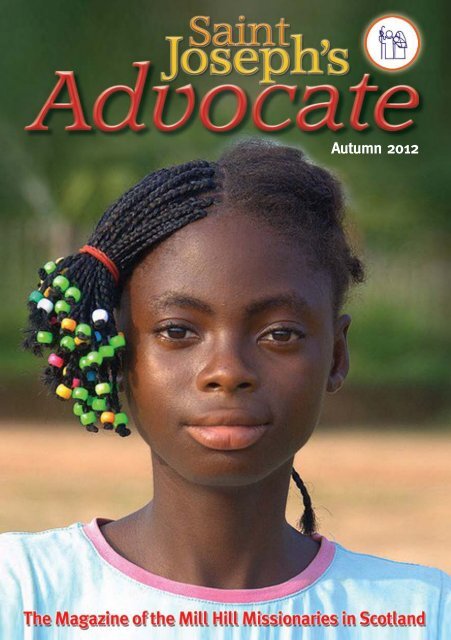

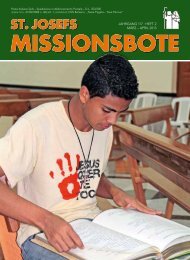
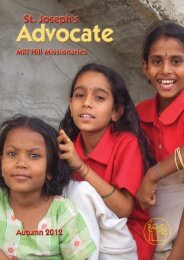
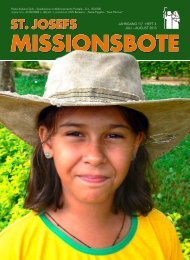

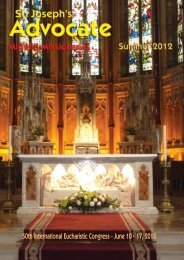
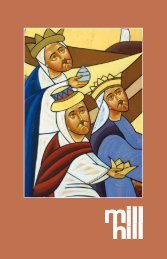
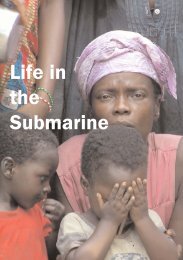

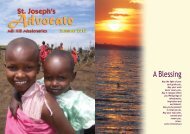
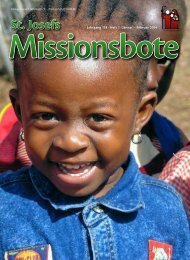
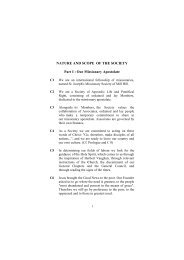

![Summer 2012 [pdf] - The Mill Hill Missionaries](https://img.yumpu.com/43011464/1/184x260/summer-2012-pdf-the-mill-hill-missionaries.jpg?quality=85)